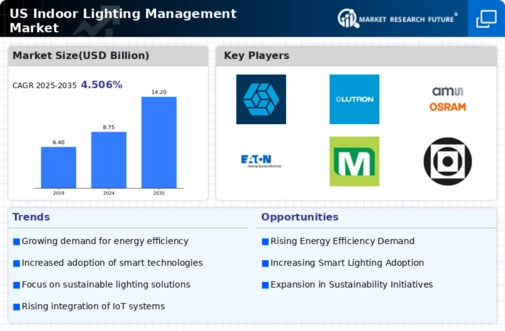Growing Demand for Sustainable Solutions
the indoor lighting-management market is experiencing a growing demand for sustainable solutions as environmental concerns become more prominent. Businesses and consumers alike are increasingly prioritizing eco-friendly practices, leading to a shift towards energy-efficient lighting options. The market for sustainable lighting solutions is projected to grow at a CAGR of approximately 8% over the next five years. This trend is driven by regulations promoting energy efficiency and sustainability, compelling organizations to adopt advanced lighting management systems. As a result, the indoor lighting-management market is evolving to meet these demands, offering products that not only reduce energy consumption but also minimize carbon footprints.
Regulatory Support for Energy Efficiency
The indoor lighting-management market benefits from strong regulatory support aimed at promoting energy efficiency. Various federal and state initiatives encourage the adoption of energy-efficient lighting solutions, providing incentives for businesses to upgrade their lighting systems. For instance, programs that offer rebates for energy-efficient upgrades have gained traction, making it financially viable for organizations to invest in advanced lighting management technologies. This regulatory environment is likely to propel the indoor lighting-management market forward, as compliance with energy standards becomes increasingly critical for businesses seeking to enhance their sustainability profiles.
Increased Focus on Workplace Productivity
The indoor lighting-management market is significantly influenced by the increased focus on workplace productivity. Research indicates that proper lighting can enhance employee performance and well-being, leading to higher productivity levels. Organizations are investing in advanced lighting management systems that allow for customizable lighting environments tailored to specific tasks. This trend is particularly evident in office spaces, where the right lighting can reduce eye strain and fatigue. As companies recognize the correlation between lighting and productivity, the demand for sophisticated indoor lighting-management solutions is expected to rise, further driving market growth.
Rising Awareness of Health and Well-being
the indoor lighting-management market is shaped by the rising awareness of health and well-being among consumers and businesses. Studies suggest that lighting quality directly impacts mood, health, and overall well-being. As a result, there is a growing emphasis on creating environments that promote mental and physical health through effective lighting management. This trend is particularly relevant in sectors such as healthcare and education, where optimal lighting conditions are essential. Consequently, the indoor lighting-management market is adapting to these needs, offering solutions that prioritize health benefits alongside energy efficiency.
Technological Advancements in Lighting Systems
The indoor lighting-management market is experiencing a surge due to rapid technological advancements in lighting systems. Innovations such as LED technology and smart sensors are transforming traditional lighting into more efficient and controllable solutions. The integration of Internet of Things (IoT) capabilities allows for real-time monitoring and management of lighting systems, enhancing user experience and energy savings. According to recent data, the adoption of LED lighting has increased by over 50% in commercial spaces, significantly impacting the indoor lighting-management market. These advancements not only improve energy efficiency but also contribute to reduced operational costs, making them attractive to businesses aiming to optimize their lighting management.
























Leave a Comment